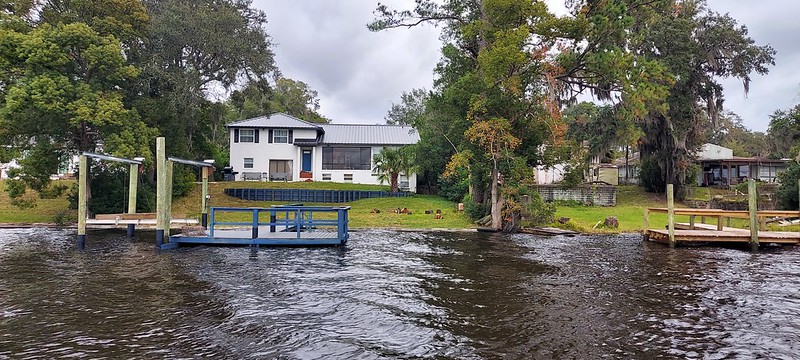
Located five miles northwest of Downtown, the neighborhood of Lake Forest has a history and built environment largely shaped by significant housing booms, bubbles and busts of early 20th century Jacksonville.
A Frankenstein-like development pattern

Lake Forest is a neighborhood with two distinct street grids representing pre- and post-World War II development trends. The west portion of the neighborhood was initially laid out during the height of the 1920s Florida Land Boom. Platted as early as 1926, the west portion of the neighborhood is characterized by a conventional grid street plan. Popular in Jacksonville before the Great Depression, streets run at right angles to each other, forming a grid. However, the larger east and north portion of the neighborhood was developed in 1944 with a curvilinear street grid. Although landscape architect Frederick Law Olmsted is recognized for designing the curvilinear pattern of streets in Riverside, Illinois, in 1868, this style of street design became popular locally after the Great Depression. As a result of the 1926 Florida real estate bust and World War II growth spurt locally, Lake Forest is a neighborhood that lives on with a mix of early and mid-20th century development patterns.


Intended to be affordable housing

During the 1920s Florida land boom, Jacksonville rapidly increased in population, leading to a housing shortage and a need for more affordable housing. As a result, the Midland Realty Company, the developers of Venetia, created plans for the Lake Forest neighborhood along Lem Turner Road. Intended to be a neighborhood catering to Jacksonville’s working class, houses were designed to be more modest in comparison to other local 1920s developments such as San Marco, San Jose and Venetia.
An early American theme was selected for the neighborhood, and a log cabin was set up to serve as the sales office. Construction began in 1925. Only a few houses had been developed by mid-1926, when it became one of the many speculative developments across Florida that began to fail. Significant residential construction finally took place in 1944. Largely built out by 1950, the majority of the neighborhood is characterized by modest frame and masonry vernacular homes.



The oldest houses in Lake Forest

The oldest remaining houses in Lake Forest were built during the height of the 1920s Florida land boom. Within a year of their completion, Florida’s first real estate bubble crashed, leading to Lake Forest becoming a failed development before its eventual 1940s renaissance.
Today, it can be challenging to spot the handful of houses that pre-date the greater Lake Forest neighborhood by nearly 20 years. Generally located on or near Lake Forest Boulevard between Delaware Avenue and Wayne Street, they serve as a reminder of residential construction that was designed and built for Jacksonville’s working-class community.


A neighborhood of oval parks

The 1920s version of Lake Forest included a pair of small oval parks as part of its construction. In 1944, two half-oval parks were added as a part of the subdivision’s expansion. Located between Marion Street and Marion Circle, Marion Park is the largest. It was named after Francis Marion (1732-1795). Rising to the ranks of general and commander of the North and South Carolina militias against the British, Marion was nicknamed the Swamp Fox because of his elusive combat tactics. Between 1825 and 1942, the fort in St. Augustine bore his name. A smaller park, Concord Park, is located a few blocks south. That park is named in honor of the battles at Lexington and Concord, Massachusetts, on April 19, 1775.


An American Revolutionary War theme

During the 1920s, the developers of Lake Forest selected an American Revolutionary War theme for their working-class residential development. While the speculative residential development did not immediately take off as originally expected, the American Revolutionary War theme lives on in the names of the neighborhood’s streets. Concord Boulevard is named in honor of the Battle of Concord. The Battle of Concord was one of the leading military engagements of the American Revolutionary War. It was fought in Concord, Massachusetts, on April 19, 1775. Along with the Battle of Lexington, it marked the outbreak of conflict between the 13 colonies and Great Britain. Connecting Concord Boulevard with Edgewood Avenue West, Bunker Hill Boulevard is named in honor of the June 17, 1775, Battle of Bunker Hill. Other American Revolutionary War-themed street names include Saratoga Boulevard, Lexington Drive, Marion Street and Paul Revere Drive.


A peninsula in the heart of the city

A unique feature of Lake Forest is its geography. Historically bounded by Moncrief Creek and the Ribault and Trout rivers, Lake Forest is one of a small number of neighborhoods in Jacksonville’s urban core situated on a peninsula. Hugging the Trout and Ribault rivers, the neighborhood’s Concord Boulevard is a quaint and winding thoroughfare that is lined with 1.60 miles of custom-built American Ranch-style riverfront homes largely built during the 1950s.



Contact Ennis at edavis@moderncities.com.






